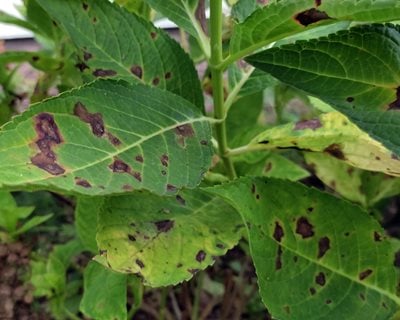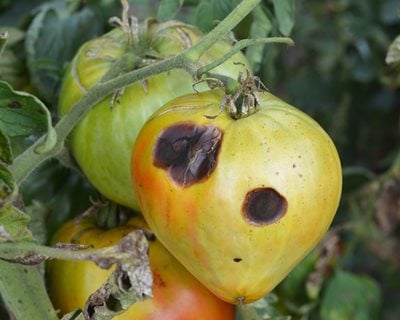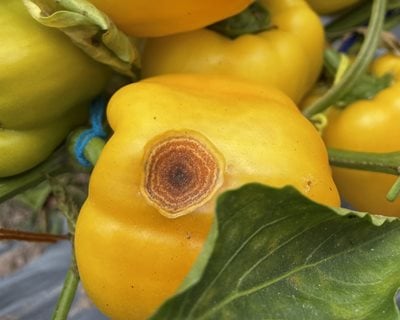How to Prevent & Treat Anthracnose
Learn how to identify this pesky fungal disease and get tips for keeping it out of your garden.
Anthracnose on hydrangea leaves. Photo by DAwee / Shutterstock.com
If you love growing tomatoes and peppers during the summer, one disease you should be on the watch for is anthracnose, an aggressive fungal disease that not only targets some of your favorite garden crops, but also a wide range of other plants, including trees, ornamental shrubs, flowers, and even houseplants.
Like many fungal diseases, anthracnose is more common during periods of high humidity and frequent rainfall. Although anthracnose rarely kills plants, the defoliation and other damage it causes can wreak havoc on their overall health and appearance. If anthracnose attacks tomatoes and other fruits, the ripening fruit will begin to rot, ruining your eagerly awaited harvest.
Unfortunately, anthracnose can spread fast and is difficult to get rid of once it takes hold. Because early detection is key, it’s important to recognize the signs of an anthracnose infection so you can act quickly to stop it in its tracks.
HOW TO IDENTIFY ANTHRACNOSE
Anthracnose is caused by several different fungi in the genus Colletotrichum and its symptoms can vary, depending on the plant it chooses as its host.
On tomatoes and other fruits, anthracnose initially appears as small, sunken dark lesions. As the fruit matures, the spots become larger and more severe and may be mushy to the touch. Ripe and overripe fruit are especially susceptible, but anthracnose can also infect green fruit, with the symptoms not developing until the fruit begins to ripen.
On trees and shrubs, anthracnose typically infects newly emerging leaves in the spring, causing irregular yellow or brown blotches. Sometimes small twigs will also be affected. Severely infected leaves may even curl and drop off prematurely, leading to defoliation.
HOW TO GET RID OF ANTHRACNOSE
If you find anthracnose in your garden, there are a number measures you can take to limit its growth and spread.
The most effective control method is to promptly prune off diseased portions of the plant (or remove the plant entirely if it’s beyond saving) and place the waste in a bag for disposal. For trees, prune to remove infected twigs and branches and discard leaves lost to defoliation to reduce the potential for reinfection. Be sure to sterilize your pruners with a disinfectant after use to prevent spread of the fungus to healthy plants (see Tool Care & Maintenance).
If you have anthracnose-infected vegetable crops that you want to salvage, applying neem oil or an organic copper-based fungicide can help prevent anthracnose from spreading. Both are considered safe for use on vegetable crops up until the day of harvest. To treat an existing infection, spray every seven days until the fungus is gone, and then repeat every two weeks to keep it from returning
Using fungicide sprays on large shade trees infected with anthracnose is often not necessary, according to experts at The Morton Arboretum. By the time disease is apparent, fungicide sprays are usually ineffective. If they are used, timing is critical. Learn more about treating anthracnose in shade trees from the Morton Arboretum.

Anthracnose on tomatoes. Photo by Radovan1 / Shutterstock.com
TIPS FOR PREVENTING ANTHRACNOSE
Although you can’t prevent the humid, wet weather conditions that can spur an outbreak of anthracnose, there are steps you can take to minimize the risk of infection. Some of these same strategies can also help prevent other fungal diseases in the garden, such as botrytis blight and powdery mildew.
- Because anthracnose spores can be spread by splashing water, avoid overhead watering by using drip irrigation or a soaker hose. Also water plants during the early hours of the day so any moisture that gets on the foliage has a chance to dry before nightfall.
- To allow for good air flow, provide adequate spacing between plants and prune or thin out dense growth.
- Keep ripening fruit off the soil surface by supporting your plants with stakes or growing them on a trellis.
- Practice good housekeeping by keeping the soil around your plants free of debris, such as dead leaves, spent flower petals, and fallen fruit.
- Avoid planting tomatoes, peppers, and other crops susceptible to anthracnose in the same area year after year. Rotating crops can help to minimize the risk of reinfection by reducing the buildup of fungal spores in the soil. Ideally, you should allow 3 to 4 years to pass before planting susceptible plants in the same location. You can also consider growing your plants in containers, but be sure to renew the soil every year.
- Because anthracnose spores can overwinter in the soil, be sure to remove plant debris from your garden every fall, especially if you’ve had an anthracnose outbreak.
HOW DOES ANTHRACNOSE SPREAD?
Like many fungal diseases, anthracnose spreads via spores that can be dispersed by the wind, splashing rainwater or overhead irrigation, allowing it to spread rapidly from plant to plant. The fungi can also overwinter on infected plant debris and in the soil, coming to life during the cool, wet weather of spring.
Many gardeners are surprised to learn that anthracnose can even be seed-borne. If you save and plant seeds from diseased fruit, you can reintroduce the fungus back into the soil.

Anthracnose on peppers. Photo by AmBNPhoto / Shutterstock.com
PLANTS SUSCEPTIBLE TO ANTHRACNOSE
Anthracnose doesn’t discriminate and will eagerly feast on many different types of garden plants. It is a common fungal disease of deciduous shade trees, especially sycamore, ash, maple, and oak. But some smaller ornamental trees, such as dogwood, are also vulnerable. Other susceptible plants include:
-
Tomatoes and other plants in the nightshade family, Solanaceae, including eggplants and peppers.
- Tropical foliage plants
- Shrubs, including rose bushes, privets, forsythia, gardenias, red twig dogwoods, and hydrangeas
- Strawberries, peaches, melons, and many other fruit
FREQUENTLY ASKED QUESTIONS
Can a tree recover from anthracnose?
Even in years when anthracnose is severe, it will generally not cause permanent damage to an established, otherwise healthy tree. Most trees are able to withstand infection and replace lost leaves with new growth. However, you should discard fallen leaves and prune off infected twigs and branches to reduce the potential for reinfection.
Can overwatering cause anthracnose?
Overwatering does not cause anthracnose, but it can create the moist environment that it needs to thrive. In fact, during dry weather, anthracnose activity slows and can even become dormant. When watering, provide enough moisture for your plant’s needs, but don’t allow the soil to become waterlogged. And don’t forget to water at the base of the plant to keep the foliage dry.
Can you eat tomatoes and other fruits infected with anthracnose?
Because anthracnose develops sunken, dark spots on tomatoes that worsen as the fruit matures, by the time the fruit is ripe enough to eat, it’s often beginning to rot. However, if you harvest the fruit as soon as it’s ripe and use it right away, you may be able to cut out the infected spots (if they are small) and still eat the rest.
How do you keep anthracnose out of the soil?
To help keep fungal spores out of the soil, remove and dispose of diseased plant parts and don’t save and plant seeds from diseased plants. If fruit becomes infected, you should remove it promptly rather than letting it drop to the ground. Practicing crop rotation will also help reduce the buildup of fungal spores in the soil.
Does anthracnose come back every year?
It can, if preventive measures aren’t taken. Anthracnose often occurs in spring and early summer during periods of cool, wet weather and usually abates once the heat of midsummer arrives. However, the fungi can overwinter in the soil and release spores the following spring, starting the cycle all over again.
RELATED:
Tomato Plant Diseases, Pests, and Problems
Eco-Friendly Pest & Disease Control
Black Spot on Roses


